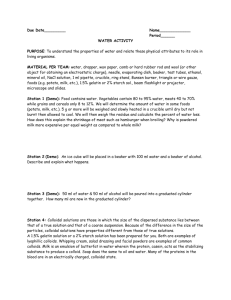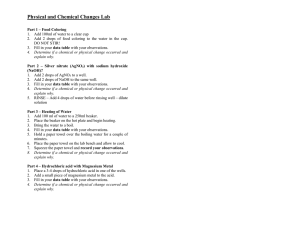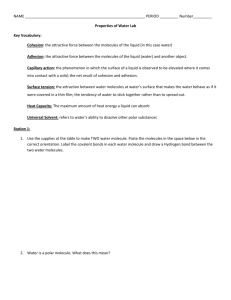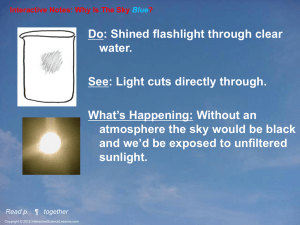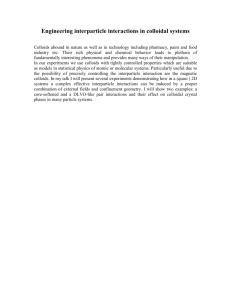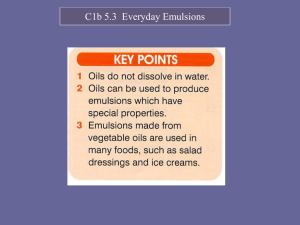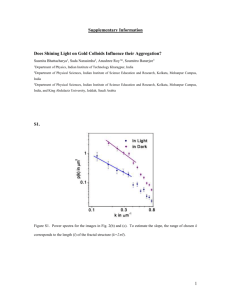EXPERIMENT 1: WATER, THE UNIVERSAL SOLVENT FOR LIFE
advertisement
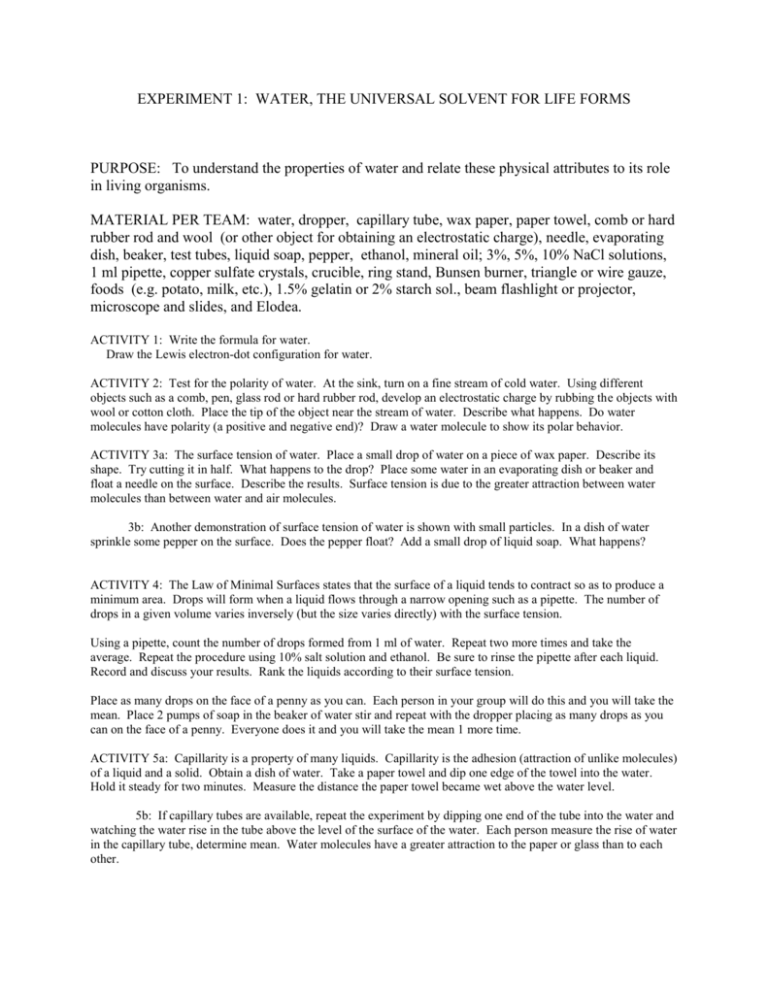
EXPERIMENT 1: WATER, THE UNIVERSAL SOLVENT FOR LIFE FORMS PURPOSE: To understand the properties of water and relate these physical attributes to its role in living organisms. MATERIAL PER TEAM: water, dropper, capillary tube, wax paper, paper towel, comb or hard rubber rod and wool (or other object for obtaining an electrostatic charge), needle, evaporating dish, beaker, test tubes, liquid soap, pepper, ethanol, mineral oil; 3%, 5%, 10% NaCl solutions, 1 ml pipette, copper sulfate crystals, crucible, ring stand, Bunsen burner, triangle or wire gauze, foods (e.g. potato, milk, etc.), 1.5% gelatin or 2% starch sol., beam flashlight or projector, microscope and slides, and Elodea. ACTIVITY 1: Write the formula for water. Draw the Lewis electron-dot configuration for water. ACTIVITY 2: Test for the polarity of water. At the sink, turn on a fine stream of cold water. Using different objects such as a comb, pen, glass rod or hard rubber rod, develop an electrostatic charge by rubbing the objects with wool or cotton cloth. Place the tip of the object near the stream of water. Describe what happens. Do water molecules have polarity (a positive and negative end)? Draw a water molecule to show its polar behavior. ACTIVITY 3a: The surface tension of water. Place a small drop of water on a piece of wax paper. Describe its shape. Try cutting it in half. What happens to the drop? Place some water in an evaporating dish or beaker and float a needle on the surface. Describe the results. Surface tension is due to the greater attraction between water molecules than between water and air molecules. 3b: Another demonstration of surface tension of water is shown with small particles. In a dish of water sprinkle some pepper on the surface. Does the pepper float? Add a small drop of liquid soap. What happens? ACTIVITY 4: The Law of Minimal Surfaces states that the surface of a liquid tends to contract so as to produce a minimum area. Drops will form when a liquid flows through a narrow opening such as a pipette. The number of drops in a given volume varies inversely (but the size varies directly) with the surface tension. Using a pipette, count the number of drops formed from 1 ml of water. Repeat two more times and take the average. Repeat the procedure using 10% salt solution and ethanol. Be sure to rinse the pipette after each liquid. Record and discuss your results. Rank the liquids according to their surface tension. Place as many drops on the face of a penny as you can. Each person in your group will do this and you will take the mean. Place 2 pumps of soap in the beaker of water stir and repeat with the dropper placing as many drops as you can on the face of a penny. Everyone does it and you will take the mean 1 more time. ACTIVITY 5a: Capillarity is a property of many liquids. Capillarity is the adhesion (attraction of unlike molecules) of a liquid and a solid. Obtain a dish of water. Take a paper towel and dip one edge of the towel into the water. Hold it steady for two minutes. Measure the distance the paper towel became wet above the water level. 5b: If capillary tubes are available, repeat the experiment by dipping one end of the tube into the water and watching the water rise in the tube above the level of the surface of the water. Each person measure the rise of water in the capillary tube, determine mean. Water molecules have a greater attraction to the paper or glass than to each other. ACTIVITY 6: Many substances form hydrates. These chemicals form compounds with water but the water molecules remain intact. Copper sulfate pentahydrate is such a substance. Place a small amount in a crucible and gently heat. Describe your results. Allow to cool and add a few drops of water. Describe what happens. We will learn more about this hydration when studying proteins. ACTIVITY 7: Food contains water. Vegetables contain 80 to 95% water, meats 40 to 70% while grains and cereals only 8 to 12%. Determine the amount of water in the foods (potato, milk, etc.) provided by your instructor. Weigh out 5 g or more and slowly heat in a crucible until dry but not burnt. Allow to cool and weigh the residue. Calculate the percent of water loss. How does this explain the shrinkage of meat such as hamburger when broiling? Why is powdered milk more expensive per equal weight as compared to whole milk? ACTIVITY 8: An emulsion may be defined as a metastable suspension of two or more substances ordinarily insoluble in each other. Place 5 ml of water and 5 ml of cottonseed oil or vegetable oil (may be stained with Sudan IV) in a test tube. Shake vigorously. How stable is this emulsion? Which liquid forms drops? Add a drop of liquid detergent to the emulsion and shake again. Describe your results. Bile, produced by the liver and stored in the gall bladder yields the same results. What is the purpose of bile in the body? Milk is a common emulsion. Examine a drop of milk under the microscope and look for fat droplets. ACTIVITY 9. Colloidal solutions are those in which the size of the dispersed substance lies between that of a true solution and that of a coarse suspension. Because of the difference in the size of the particles, colloidal solutions have properties different from those of true solutions. Prepare 1.5% gelatin solutions or 2% starch solutions. These are examples of lyophillic colloids. Whipping cream, salad dressing and facial powders are examples of common colloids. Milk is an emulsion of butterfat in water wherein the protein, casein, acts as the stabilizing substance to produce a colloid. Soap does the same to oil and water. Many of the proteins in the blood are in an electrically charged, colloidal state. A test for colloids is the Tyndall effect. Pass a beam of light through a beaker containing a sodium chloride solution and one containing a colloid. What is the difference? Brownian movement noted under the microscope is another colloidal property. Place a drop of liquid from a solution on one half of a slide and a drop from a colloid on the other half. Use cover slips. Describe the movement seen through a microscope. Can you see movement in both liquids? ACTIVITY 10, Determine the boiling point (temperature) of water. Add 5 grams of salt, and re-determine the boiling point of that solution.
